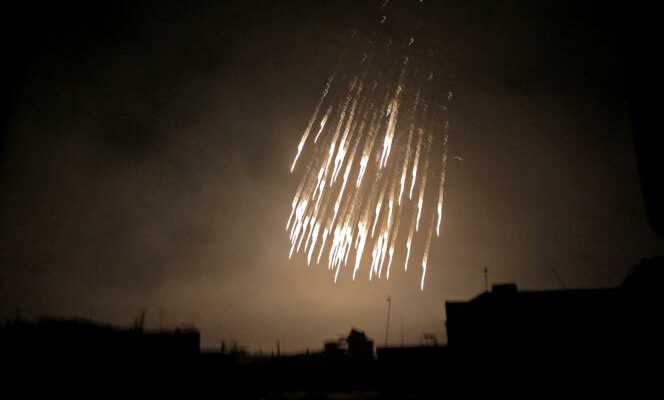Russia is continuing its offensive in Ukraine, which began on February 24, and is increasing the bombardments on the various cities of the country. In recent days, Ukrainian authorities have repeatedly accused Russian forces of using white phosphorus bombs, particularly dangerous incendiary weapons. What is it about ? How is the use of these weapons regulated? Have white phosphorus bombs ever been used? The world make the point.
Why does Ukraine accuse Russia of using white phosphorus bombs?
“The Russian air force has started dropping phosphorus bombs on Rubizhne”, near Luhansk, in eastern Ukraine, accused the governor of the region, Serguiï Gaïdaï, on Thursday March 24. At least four people died in the bombardment, including two children, and six others were injured, according to the governor. “The Russians are dying, they can’t move forward, that’s why they started using heavy weapons”added Mr. Gaïdaï.
The day before, the mayor of Irpin, a city located in the suburbs of kyiv, accused the Russian forces, on his Telegram account, of having used the same type of weapons the previous day, denouncing a ” crime against humanity “. Oleksandr Markouchine relies on the photographs of a Ukrainian journalist, Oleg Hryb, showing white streaks falling from the sky in the middle of the night. Contacted by BFM-TV, the city councilor said: “Specialists must come to confirm this 100 %. Today, we consider 90% that these are phosphorus bombs. »
Questioned on BFM-TV on March 23, the Ukrainian ambassador to France, Vadym Omelchenko, could not confirm the use of white phosphorus at Irpin. On the other hand, he assured that Ukraine had “evidence” of various similar attacks in the country, which will be sent to the International Criminal Court.

Also listen War crimes in Ukraine: the hunt for evidence
What is a white phosphorus bomb?
White phosphorus is a chemical that ignites when exposed to oxygen. The chemical reaction then creates heat of about 815°C, light and thick white smoke. In the 1830s, phosphorus was used to develop the match industry, before it was banned in 1910 because of its toxicity.
In the military field, white phosphorus can be used for different purposes. Among other things, to create smoke screens, conceal troop movements, illuminate strategic areas… Some armed forces, however, use it as an incendiary weapon by targeting people or equipment.
“Incendiary weapons are among the most cruel weapons used in armed conflict in the world today”emphasizes, for its part, Human Rights Watch (HRW), in a report published in 2018. In another report dated November 2015the NGO explains that “white phosphorus can cause horrific injuries no matter how it’s used”. He is “highly soluble in fats and therefore in human flesh”, writes HRW. When white phosphorus comes into contact with the skin, it causes severe thermal and chemical burns, often to the bone. “Burns on only 10% of the body are often fatal”says HRW.
Is the use of white phosphorus bombs allowed?
White phosphorus bombs are not chemical weapons (asphyxiating or toxic products) – the use of which is prohibited by the Chemical Weapons Convention (CIAC), entered into force in 1997. White phosphorus bombs fall into the category of incendiary weapons. Their use is codified by Protocol III Convention on Certain Conventional Weapons (CCW), signed in Geneva and entered into force in 1983. This treaty includes 115 States Partiesincluding France, the United States, Russia and Ukraine.
This text aims to prohibit or limit the use of these weapons “which may be considered to produce excessive traumatic effects or to strike indiscriminately”. With this in mind, CCW Protocol III ” forbidden in all circumstances » the use of incendiary weapons against civilians or civilian objects (all objects that are not military objectives). Besides, “a military objective located within a concentration of civilians” cannot be attacked with incendiary weapons.
Article 8 of the Rome Statute of the International Criminal Courtwhich entered into force in 2002, provides the most recent definition of what constitutes a war crime. ” The destruction (…) property, not justified by military necessity”, and the fact of “intentionally directing attacks against the civilian population or civilian objects” are thus prohibited. If proven, breaches of CCW Protocol III may therefore constitute war crimes.
Interviewed on BFM-TVon March 23, the military historian and former colonel Michel Goya spoke bluntly of a weapon “allowed” corn ” disgusting “. In its report published in 2018Human Rights Watch denounces ” gaps “ of CCW Protocol III that limit its ability to protect civilians:
– its definition of incendiary weapons excludes so-called “multipurpose” ammunition, in particular those containing white phosphorus. They ignite and cause burns but are, officially, primarily designed for other uses (eg signaling);
– the use of air-to-ground incendiary weapons against concentrations of civilians is prohibited. But the use of ground-to-ground incendiary weapons is authorized in populated areas when the military objective is “well away from the concentration of civilians and when all possible precautions have been taken”.
“The humanitarian benefits of a total ban on incendiary weapons would be immense”summarizes Human Rights Watch.
Have white phosphorus bombs ever been used?
Incendiary bombs have been used repeatedly in recent armed conflicts. This is particularly the case in Syria, a country that has not signed CCW Protocol III. Human Rights Watch counted thirty such attacks, including white phosphorus bombs, carried out by the Syrian-Russian military alliance in the first seven months of 2018. From November 2012 to November 2017, the NGO documented more than ninety arson attacks in the country.
Israel, which is also not a state party to this treaty, has been accused of “war crimes” by Amnesty International after the use of white phosphorus bombs in Gaza during the winter of 2008-2009. The Israeli army admitted to having used this type of weapon during the second Lebanon war in the summer of 2006. The same bombs that the United States launched in Iraq, during the battle of Fallouja, in November 2004, against the rebel forces that had taken control of the city.
White phosphorus ammunition was also used by the US-led coalition against the Islamic State organization in Iraq and Syria in 2017and by the Saudi-led coalition in Yemen in 2016. More recently, in late 2020, Azerbaijani forces used white phosphorus ammunition against Armenian soldiers on the Nagorno-Karabakh front.
